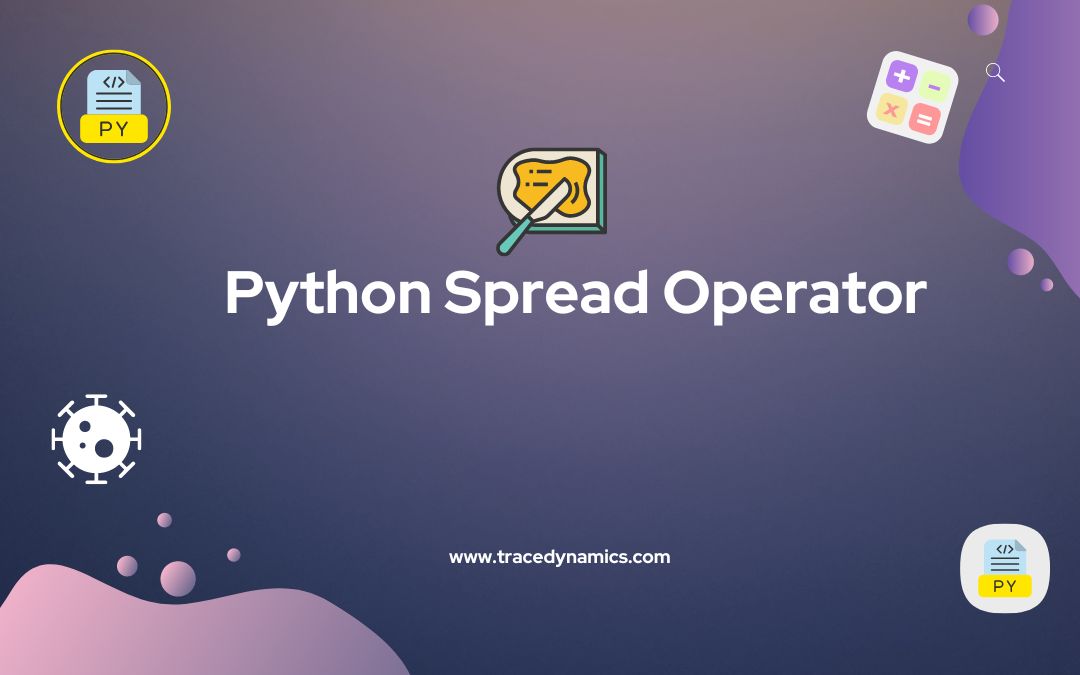
Python
What is the Spread Operator?
Represented by three dots (...), the spread operator skillfully unpacks iterable objects like lists, tuples, and dictionaries into function arguments or expressions. Consequently, it expands the iterable object, placing its elements into the target location. This operator acts like a magical wand, simplifying your code and enhancing its readability and conciseness.
Why Use the Spread Operator?
- Improved Code Readability: It enhances clarity, especially with longer lists.
- Reduced Boilerplate Code: By eliminating manual listing of each element, it saves time and effort.
- Enhanced Flexibility: The operator dynamically unpacks different iterable objects as per your needs.
Examples of the Spread Operator in Action:
-
Unpacking Lists:
fruits = ["apple", "banana", "cherry"]
def print_fruits(fruit1, fruit2, fruit3):
print(f"My favorite fruits are: {fruit1}, {fruit2}, and {fruit3}")
print_fruits(*fruits)
For instance, this code unpacks the fruits list, passing each element to the print_fruits function.
-
Combining Lists:
colors1 = ["red", "green"]
colors2 = ["blue", "yellow"]
all_colors = [*colors1, *colors2]
print(all_colors)
Similarly, this code combines elements from two lists into a new list, showcasing the operator’s versatility.
-
Unpacking Dictionaries:
person = {"name": "John", "age": 30, "city": "New York"}
def print_person(name, age, city):
print(f"Name: {name}, Age: {age}, City: {city}")
print_person(**person)
This code, for example, unpacks the person dictionary, passing its key-value pairs to the print_person function.
Spread Operator vs. Other Methods:
Although the spread operator is highly advantageous, other methods also deserve consideration:
- Looping: For instance, you can use a loop to iterate over an iterable object and access its elements.
- List comprehension: This method allows the creation of a new list from an existing one.
- f-strings: Alternatively, f-strings format strings using elements from an iterable.
Conclusion:
As a versatile tool in Python, the spread operator significantly enhances code conciseness, readability, and flexibility. Its proper understanding and application can elevate your Python programming skills to new heights.
Official Documentation:
Frequently Asked Questions
What is the Python Spread Operator?
The spread operator in Python, denoted by three dots (…), unpacks elements from iterable objects like lists, tuples, and dictionaries.
Can the Spread Operator be used with dictionaries?
Yes, the spread operator can be used to unpack dictionaries into function arguments or other structures.
Is the Spread Operator available in all versions of Python?
The spread operator is available in Python 3.5 and later versions.
How does the Spread Operator differ from traditional looping?
The spread operator provides a concise way to unpack elements from iterables, as opposed to looping through each element.
Can the Spread Operator be used for deep copying?
No, the spread operator performs shallow copying and does not create deep, independent copies of nested objects.
Is it possible to use the Spread Operator with functions?
Yes, the spread operator can pass elements of an iterable as separate arguments to a function.
Can the Spread Operator combine multiple lists?
Yes, the spread operator can concatenate or combine elements from multiple lists into one.
How does the Spread Operator handle string data types?
When applied to a string, the spread operator spreads its individual characters as iterable elements.
Does the Spread Operator affect the original iterable?
No, the spread operator does not modify the original iterable object.
Can the Spread Operator be used with tuples?
Yes, the spread operator can unpack elements from tuples, just as with lists and dictionaries.
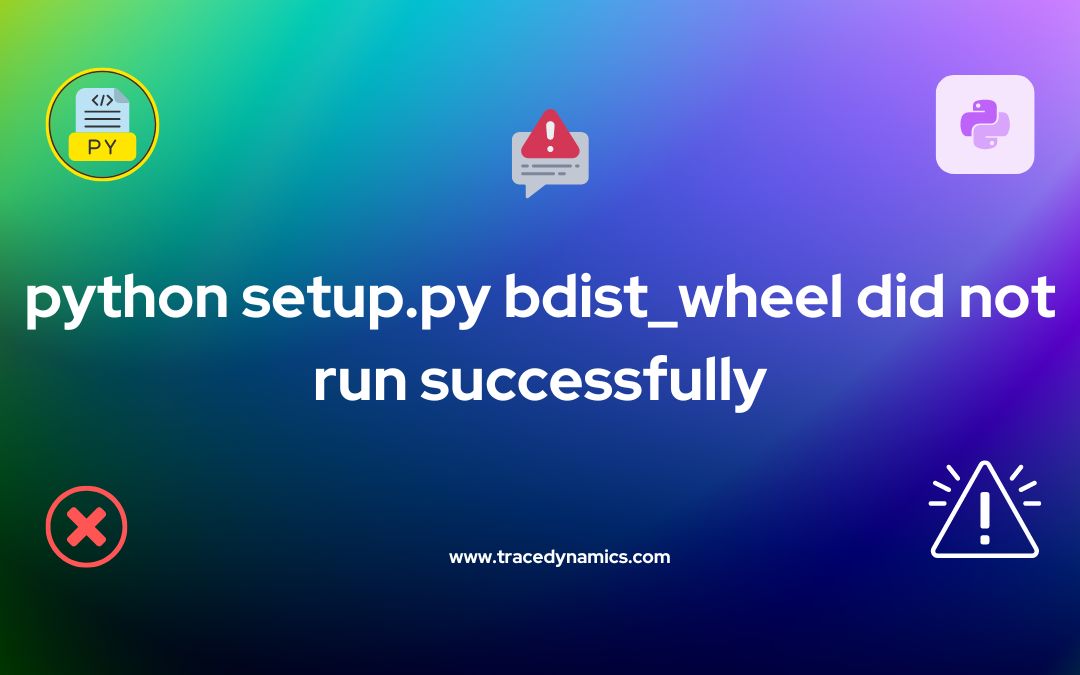
Python
Ah, the dreaded error message: “python setup.py bdist_wheel did not run successfully”. It’s enough to send shivers down the spine of any Python developer. Fear not, fellow programmer, for I am here to guide you through the murky depths of this error and help you emerge victorious!
Unraveling the Mystery: Why Your Wheel Won’t Spin
Before we delve into solutions, let’s understand the cause of this error. When you run python setup.py bdist_wheel, Python attempts to build a wheel, a platform-specific compressed archive containing your Python package and its dependencies. However, this process can encounter various obstacles, leading to the dreaded error message.
Here are some common culprits:
- Missing dependencies: Your package might require specific libraries not installed on your system.
- Incompatible dependencies: Conflicting versions of dependencies can cause build failures.
- Platform-specific issues: Certain libraries might not be compatible with your operating system or Python version.
- Errors in your setup.py script: Typos, syntax errors, or incorrect configurations can derail the wheel build process.
Diagnosing the Problem: Identifying the Root Cause
To effectively address the error, we need to pinpoint its exact cause. Here are some steps to diagnose the issue:
- Review the build output: Carefully examine the output generated when running python setup.py bdist_wheel. Look for specific error messages that might indicate the source of the problem.
- Check your dependencies: Ensure all your package dependencies are installed and compatible with your Python version. Use tools like pip list and pip show to verify their versions.
- Analyze your setup.py script: Double-check your setup script for any typos, syntax errors, or incorrect configurations. Look for missing dependencies, improper version specifications, or incompatible platform settings.
- Seek online resources: Search online forums, documentation, and Stack Overflow for similar error messages and solutions. Sharing your specific error message along with your setup script can yield valuable insights.
Building the Wheel: Strategies for Success
Once you have identified the cause of the error, you can implement the appropriate solution. Here are some strategies to overcome the “bdist_wheel” woes:
- Install missing dependencies: Use pip install to install all missing dependencies required by your package. Ensure you install the correct versions compatible with your Python environment.
- Resolve conflicting dependencies: If conflicting versions of dependencies are causing issues, consider using virtual environments to isolate different versions for different projects. Alternatively, update or downgrade specific dependencies to ensure compatibility.
- Address platform-specific issues: If you encounter platform-specific issues, consult the documentation of the problematic library. Look for platform-specific installation instructions or alternative libraries that work on your system.
- Fix setup.py errors: Meticulously review your setup script and fix any identified typos, syntax errors, or configurations. Ensure all dependencies are properly listed, version specifications are accurate, and platform settings are correct.
- Seek help from the community: If you’re still struggling, don’t hesitate to reach out to the Python community. Post your issue on forums, Stack Overflow, or dedicated mailing lists. Sharing your problem details and setup script will likely connect you with someone who has faced and conquered a similar challenge.
Beyond the Wheel: Tips for Smooth Sailing
By implementing these strategies, you can overcome the “bdist_wheel” error and build your Python packages successfully. But to truly master the wheel, remember these tips for smooth sailing:
- Maintain a clean and well-organized setup.py script.
- Document your dependencies clearly.
- Test your packages thoroughly on different platforms.
- Stay updated with the latest Python versions and libraries.
- Build virtual environments for different projects to avoid dependency conflicts.
By adhering to these best practices, you can ensure a smooth and efficient Python development experience, leaving the dreaded “bdist_wheel” error far behind. So, roll up your sleeves, embrace the challenge, and conquer the Python wheel!
Frequently Asked Questions (FAQs)
What does 'python setup.py bdist_wheel did not run successfully' mean?
This error indicates that Python encountered a problem while attempting to build a wheel package, often due to missing dependencies, syntax errors in setup.py, or compatibility issues.
How can I diagnose the cause of this error?
To diagnose, review the build output for specific error messages, check your package dependencies, and ensure your setup.py script is free from errors.
What are common causes of this error?
Common causes include missing or incompatible dependencies, platform-specific issues, or errors in the setup.py script.
How can I fix missing dependency issues?
Install any missing dependencies using pip install and ensure they are compatible with your Python environment.
What should I do if I have conflicting dependencies?
Resolve conflicting dependencies by creating virtual environments or updating/downgrading specific dependencies.
Can platform-specific issues cause this error?
Yes, platform-specific compatibility issues with libraries can cause this error. Consult the library documentation for platform-specific instructions.
How can I correct errors in my setup.py script?
Carefully review your setup.py script for syntax errors, typos, or incorrect configurations and correct them.
Is there a way to seek help for this error online?
Yes, you can search online forums, Stack Overflow, or Python community resources for similar issues and solutions.
Are there any best practices to avoid this error in the future?
Maintain a clean setup.py, document dependencies clearly, test on different platforms, and stay updated with Python versions and libraries.
What role do virtual environments play in resolving this error?
Virtual environments can isolate dependencies for different projects, helping to manage conflicting versions and avoid such errors.
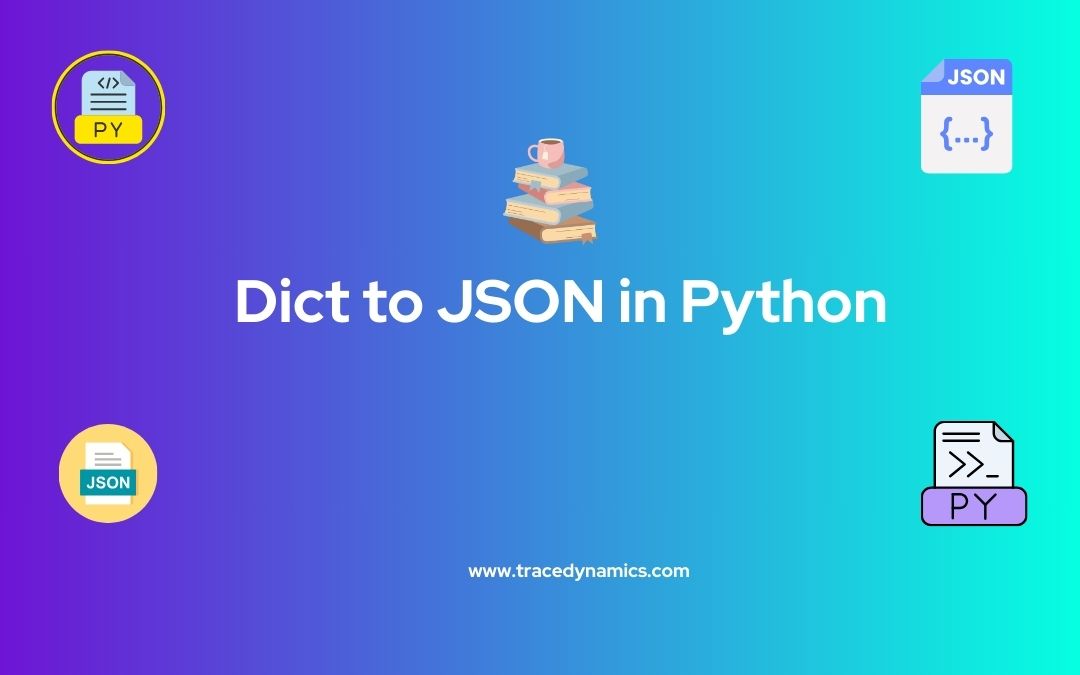
Python
Converting a Python dictionary to JSON (JavaScript Object Notation) is a fundamental task encountered in various data processing and web development scenarios. This article explores various techniques for achieving this conversion, including built-in functions, libraries, and custom methods.
Understanding the Need for Dict to JSON Conversion
Dictionaries are native data structures in Python, used for storing key-value pairs. JSON offers a lightweight and widely used format for data interchange between applications and platforms. Converting dictionaries to JSON enables efficient data serialization, transmission, and interoperability.
Built-in Functions for Dict to JSON Conversion
The Python standard library provides the json module for handling JSON data. This module offers two primary functions for dict to JSON conversion:
1. json.dumps(dict):
This function converts a Python dictionary to a JSON string. It takes the dictionary object to be converted as a single argument and, by default, sorts the dictionary keys using default separators and indentations.
Python
data = {
"name": "John",
"age": 30,
"hobbies": ["Reading", "Coding", "Music"]
}
json_string = json.dumps(data)
print(json_string)
# Output: {"name": "John", "age": 30, "hobbies": ["Reading", "Coding", "Music"]}
2. json.dump(dict, file):
This function writes the JSON representation of a dictionary directly to a file. It takes the dictionary object and the file object where the data is to be written.
Python
with open("data.json", "w") as f:
json.dump(data, f)
Advanced Techniques for Dict to JSON Conversion
1. Customizing the Output:
The json.dumps() function offers various arguments for customizing the output, such as sort_keys, indent, and separators.
Python
json_string = json.dumps(data, sort_keys=True, indent=4, separators=(",", ": "))
print(json_string)
# Output:
# {
# "age": 30,
# "hobbies": [
# "Coding",
# "Music",
# "Reading"
# ],
# "name": "John"
# }
2. Handling Complex Data Types:
Dictionaries can contain various data types, including nested dictionaries and lists. The json module automatically converts these types to their JSON equivalents, but custom handling might be needed for specific non-serializable objects.
3. Using External Libraries:
Libraries like simplejson and orjson offer alternative implementations for JSON serialization with potentially better performance and additional features.
4. Customizing Conversion with Functions:
For complex scenarios, define custom functions to handle specific aspects of the conversion process, such as applying formatting or filtering data.
Choosing the Right Technique
Choose the best approach for converting a dict to JSON in Python based on factors like data complexity, customization requirements, performance needs, and specific data handling.
Best Practices for Dict to JSON Conversion
- Use the built-in functions for simple cases.
- Customize the output format as needed.
- Handle non-serializable data types appropriately.
- Consider performance when dealing with large datasets.
- Utilize libraries for advanced features and optimization.
Conclusion
Understanding how to convert dictionaries to JSON in Python empowers you to efficiently store, transport, and exchange data across various applications and platforms. By mastering the built-in functions, advanced techniques, and best practices, you can ensure robust and flexible data processing in your Python code.
Additional Resources
Frequently Asked Questions
What is dict to JSON conversion in Python?
Dict to JSON conversion in Python involves transforming a Python dictionary into a JSON formatted string.
Why is dict to JSON conversion important?
It’s crucial for data serialization, transmission between different systems, and for working with web APIs.
What is the json.dumps() method in Python?
The json.dumps() method converts a Python dictionary to a JSON formatted string.
Can json.dumps() handle complex data structures?
Yes, json.dumps() can process nested dictionaries, lists, and standard data types in Python.
How do I write a JSON string to a file in Python?
Use json.dump() method, which writes the JSON string directly to a file.
Can I customize the JSON output format?
Yes, using json.dumps() with arguments like sort_keys, indent, and separators allows customization.
Are there external libraries for dict to JSON conversion?
Yes, libraries like simplejson and orjson offer additional functionality and performance enhancements.
How do I handle non-serializable objects in dict to JSON conversion?
For non-serializable objects, define custom serialization functions or use a library that supports their conversion.
What are the best practices for dict to JSON conversion in Python?
Use built-in functions for simplicity, customize as needed, and handle non-serializable objects appropriately.
How does dict to JSON conversion support web development?
It allows seamless data exchange between Python backend and JavaScript frontend or APIs.
Can dict to JSON conversion handle data from databases?
Yes, it’s often used to convert query results into JSON for API responses or data processing.
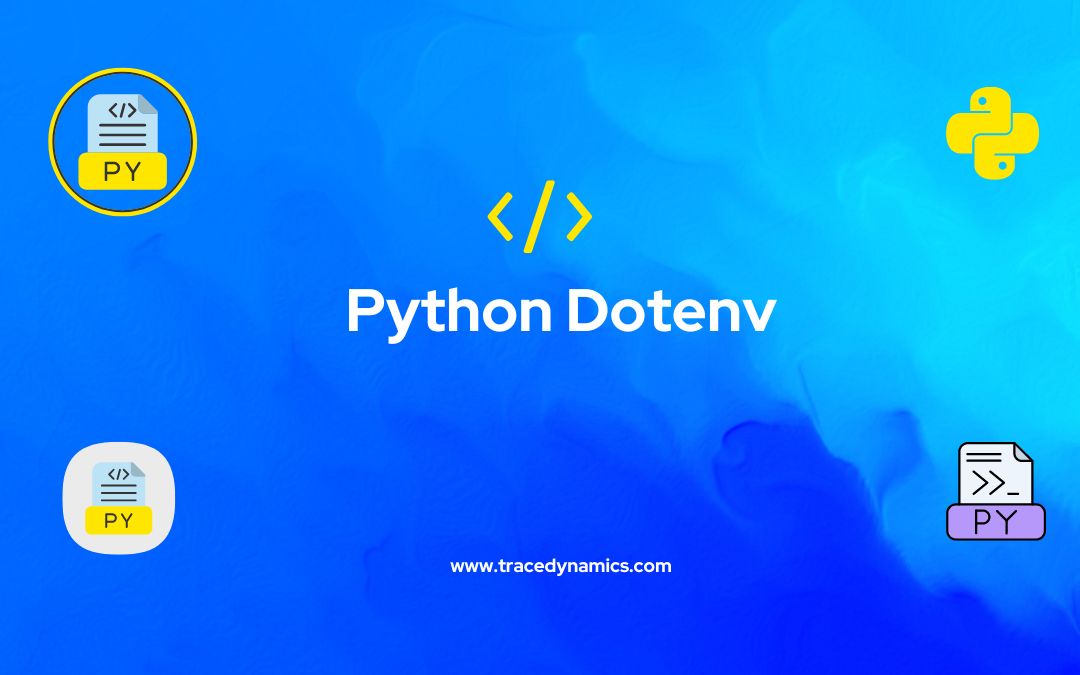
Python
Python dotenv is an essential tool for developers looking to manage environment variables in their applications effectively. This article delves into various aspects of Python dotenv, offering insights and practical examples to enhance your coding practices.
Key Takeaways
- Understand Python dotenv and its role in managing environment variables.
- Learn how to set up and use Python dotenv in projects.
- Explore best practices and security considerations for using environment variables.
- Troubleshoot common issues associated with Python dotenv.
- Discover real-world applications and advanced features of Python dotenv.
dotenv is a module that simplifies the management of environment variables in Python applications. It allows developers to store configuration separate from code, in line with the twelve-factor app methodology. Using dotenv, developers can easily manage environment settings for development, testing, and production stages, enhancing security and flexibility.
Setting Up Python Dotenv
To begin using dotenv, you need to install the package and create an .env file to store your environment variables.
pip install python-dotenv
Create a file named .env in your project’s root directory and add your environment variables in the format KEY=VALUE.
Loading and Using Environment Variables
Once the setup is complete, you can load and use environment variables in your Python code.
from dotenv import load_dotenv
load_dotenv()
Accessing Variables:
import os
SECRET_KEY = os.getenv("SECRET_KEY")
Best Practices and Security Considerations
When using environment variables, it’s crucial to follow best practices to maintain security and efficiency.
- Keep .env Files Secure: Never commit .env files to version control. Add them to .gitignore.
- Separate Development and Production: Use different environment variables for development and production.
- Validate Variables: Ensure that your application validates the existence and format of the variables.
Troubleshooting Common Issues
Developers may encounter issues like variables not loading or conflicts with system variables. To troubleshoot:
Real-World Examples and Case Studies
In real-world scenarios, dotenv is used for:
- Database Configuration: Storing database connection strings and credentials securely.
- API Keys: Managing API keys for various third-party services.
- Application Settings: Customizing application settings based on the environment.
Advanced Usage of Python Dotenv
For advanced usage, dotenv offers features like:
- Variable Interpolation: Using values of other variables in the .env file.
- Loading from Different Files: Loading environment variables from files other than .env.
Integration with Python Modules
dotenv can be integrated with various Python modules for enhanced functionality. For instance, it works well with the os module for file handling operations.
import os
from dotenv import load_dotenv
load_dotenv()
directory = os.getenv("DIRECTORY_PATH")
files = os.listdir(directory)
Python shutil: Complementing Dotenv for File Management
The shutil module in Python, when used alongside dotenv, can aid in file operations like copying, moving, and deleting files based on environment-specific paths.
import shutil
from dotenv import load_dotenv
load_dotenv()
source = os.getenv("SOURCE_FILE")
destination = os.getenv("DESTINATION_PATH")
shutil.copy(source, destination)
Handling Path Operations with os.path.join
The `os.path.join` method is a critical tool in Python for constructing file paths in a way that is both robust and less prone to errors. It intelligently combines path components and automatically uses the correct directory separator for the operating system, simplifying file path management, especially in cross-platform applications.
Key Features and Best Practices
`os.path.join` takes multiple path components as arguments and returns a single path string. It’s particularly useful in dynamic path construction, ensuring cross-platform compatibility. Best practices include avoiding hard-coded separators and combining it with other `os.path` functions for enhanced functionality.
import os
path = os.path.join('directory', 'subdirectory', 'file.txt')
For more detailed insights into file path operations in Python, visit [Mastering File Path Operations](https://www.tracedynamics.com/os-path-join-python).
Integration with Dotenv
Combining `os.path.join` with dotenv enhances file path management based on environment-specific configurations. It is ideal for scenarios where file paths vary between development and production environments.
Advanced Features of Python Dotenv
Variable Interpolation
Python dotenv’s variable interpolation feature enhances configuration management by allowing dynamic references within the .env file. This functionality is particularly useful for complex settings.
# .env file
API_URL="https://api.example.com"
DATABASE_URL="mysql://user:${API_KEY}@localhost:3306/database"
API_KEY="1234567890abcdef"
In this example, the DATABASE_URL variable dynamically references the value of API_KEY, promoting centralized and flexible configuration management.
Custom .env File Paths
Python dotenv typically loads variables from the .env file in the project’s root directory, but it can also load from a custom path. This is beneficial for projects with unique structures or multiple environment configurations.
from dotenv import load_dotenv
load_dotenv("/path/to/custom/.env")
Custom paths enable maintaining distinct .env files for different environments like development, testing, and production.
Overriding System Environment Variables
Python dotenv can override system-level environment variables, ensuring the use of specific configurations regardless of existing system settings.
from dotenv import load_dotenv
load_dotenv(override=True)
This feature is essential for consistent configuration but should be used cautiously to avoid unintended behavior.
By leveraging these advanced features, you can fully utilize Python dotenv for effective, dynamic, and secure configuration management in your Python projects.
Practical Implementations and Case Studies
Case studies showcasing the use of dotenv in different scenarios.
Case Study: E-commerce Platform
An e-commerce platform uses dotenv to manage API keys for payment gateways and set different pricing configurations for testing and production environments.
Case Study: Data Analytics Application
A data analytics application uses Python dotenv for database configurations, ensuring secure and separate settings for development and production databases.
Tables with Relevant Facts and Information
| Feature |
Description |
| Variable Interpolation |
Allows using the value of one variable within another. |
| Custom File Paths |
Enables specifying a custom path for the .env file. |
| Override System Vars |
Permits overriding system-level environment variables. |
Conclusion
Python dotenv stands out as an indispensable tool for developers aiming to effectively manage their environment variables. Its ease of use, coupled with its robust flexibility and security features, makes it an invaluable asset in any Python project. By adhering to best practices and utilizing its advanced functionalities, developers can unlock the full potential of Python, significantly enhancing their development workflow.
Additional Resources
For more information and further reading, explore the following resources:
Frequently Asked Questions (FAQs)
What is Python dotenv and its purpose?
Python dotenv is a module for managing environment variables, separating configuration from code to enhance security and flexibility.
How do I install Python dotenv?
Install Python dotenv using pip: `pip install python-dotenv`.
Can Python dotenv manage database configurations?
Yes, it’s ideal for managing different database configurations for development and production.
Is storing API keys in .env files secure?
Yes, as long as the .env file is not committed to version control and is kept secure.
What is variable interpolation in Python dotenv?
Variable interpolation allows using the value of one variable within another in the .env file.
Can I use multiple .env files in one project?
Yes, Python dotenv allows multiple .env files for different environments or purposes.
How are environment variables accessed in Python?
After loading with dotenv, use `os.getenv(‘VARIABLE_NAME’)` to access variables.
What are common issues with Python dotenv?
Issues include variables not loading, conflicts with system variables, and file location errors.
Can Python dotenv override system environment variables?
Yes, it can be configured to override system-level environment variables.
How does Python dotenv handle custom file paths?
Python dotenv can load variables from custom paths instead of the default .env file.
What are the benefits of using os.path.join with Python dotenv?
It ensures robust and error-free file path construction across different operating systems.
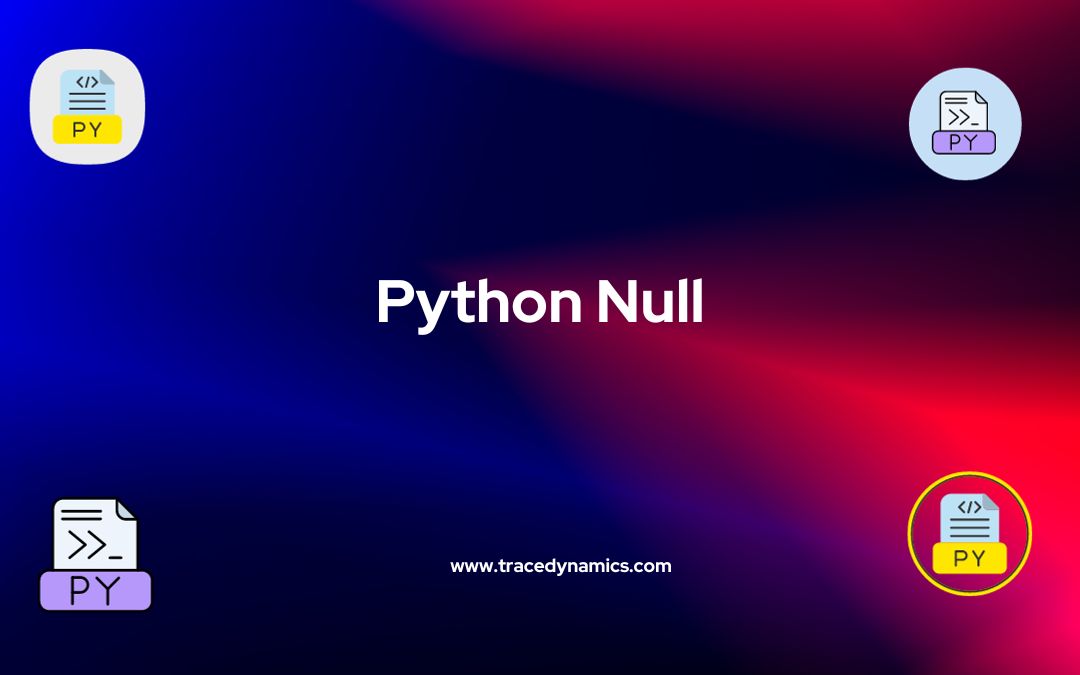
Python
Python Null: Python stands out as a highly versatile and widely-used programming language, known for its readability and simplicity. One critical aspect in Python programming involves understanding and handling ‘null’, represented by the None keyword. Delving deep into Python’s approach to null values, this guide highlights their significance in data manipulation and analysis, alongside best practices for effective usage in Python coding.
Key Takeaways:
- Understand Python’s
None type and its role in representing null values.
- Explore the usage of
None across various Python scenarios, such as in functions and conditional statements.
- Uncover the nuances of managing null values in Pandas, a crucial library for Python data analysis.
- Recognize the importance of properly handling null values during data preprocessing and visualization.
Introduction to Python Programming
Python’s approach to coding, which prioritizes readability and efficiency, has made it a top choice for diverse applications ranging from web development to data science. Handling null values, represented by the None type in Python, is a fundamental element in Python programming. This guide explores the concept of ‘null’ in Python and demonstrates its use in various scenarios.
What is Python ‘Null’?
Python uses the keyword None to define a null value or a void. Being an object and a distinct data type (NoneType), it signifies the absence of a value or a null state.
Understanding None in Python
None, as the sole instance of the NoneType data type, differs from False, 0, or an empty string. In Python, None symbolizes the absence of a value, rather than ‘nothing’.
# Example of None
a = None
if a is None:
print("a is None")
else:
print("a is not None")
Comparing None with Other Types
Understanding how None compares with other types in Python is crucial. Unlike False, 0, or an empty string, None has a unique role and meaning in Python.
# Comparison examples
if not None:
print("None is False")
if None == 0:
print("None is 0")
if None == "":
print("None is an empty string")
Usage of None in Python
Python employs None in various contexts, including functions, default arguments, and return values.
Functions and None
Python functions often use None as a default argument or a return value.
# Function returning None
def my_func():
return None
Conditional Statements and None
Python commonly uses None in conditional statements to check if a variable has a value other than None.
# Conditional statement with None
a = None
if a is None:
print("a is None")
Handling Null Values in Pandas
Pandas, an essential Python library for data manipulation and analysis, offers various methods for effective null value handling.
Pandas DataFrame and Null Values
Pandas uses methods like isnull() and notnull() to identify and filter null values in DataFrames.
# Example of using isnull() in Pandas
import pandas as pd
df = pd.DataFrame({"A": [1, 2, None, 4]})
print(df.isnull())
Strategies for Dealing with Missing Data
In Pandas, you have several active strategies to tackle missing data, each serving different scenarios. Firstly, you can fill null values with a specific value, a method that works well when you want to retain all rows or columns while replacing missing data with a default value. For instance:
# Actively filling null values
df.fillna(0, inplace=True)
Additionally, you might choose to drop rows or columns containing null values. This approach is particularly effective when missing data significantly impacts your analysis or results. Here’s how you can actively apply this method:
# Proactively dropping rows with null values
df.dropna(inplace=True)
Another approach involves interpolating missing values based on other data, a technique that’s especially useful in time series analysis. This method helps you estimate the missing values by considering the trend or pattern in your data.
Furthermore, these strategies allow you to maintain the integrity of your data analysis, ensuring that the conclusions you draw are based on the most accurate and complete data available.
Python Null in Real-World Scenarios
When dealing with real-world data, you often encounter missing or null values. Actively managing these values is critical, especially in fields like machine learning, data mining, and statistical analysis.
Case Study: E-Commerce Data Analysis
Imagine you’re analyzing an e-commerce dataset containing customer information, including null values in columns like ‘Age’ or ‘Purchase History’. You must handle these null values effectively to ensure accurate customer segmentation or to develop precise recommendation systems. For instance, you might use interpolation to estimate missing ages or default values for missing purchase histories.
Practical Example: Weather Data Processing
Consider a dataset with weather measurements, where missing values are a common occurrence. In this case, you could use time-series specific methods to fill or predict missing values, ensuring your weather predictions or analyses are as accurate as possible. This proactive handling of null values can significantly enhance the reliability of your weather-related insights or forecasts.
Through these examples, it becomes clear that effectively handling null values is not just a technical necessity but a fundamental aspect of ensuring the accuracy and reliability of any data-driven endeavor.
Frequently Asked Questions
How do I handle null values in a Pandas DataFrame?
Use methods like fillna(), dropna(), or interpolate() depending on your data and requirements.
Can null values affect the outcome of my data analysis?
Yes, null values can significantly impact the results of data analysis if not handled properly.
What are some common strategies for filling null values in a dataset?
Common strategies include filling with a constant value, using measures like mean or median, or employing predictive modeling techniques.
Is it better to remove or impute null values in a dataset?
The decision depends on the context and nature of your data, as well as the proportion of null values.
How can null values impact machine learning models?
Null values can lead to biases or errors in machine learning models if not appropriately handled.
What are the best practices for documenting null value handling in code?
Clearly comment on your code regarding the handling of null values and the rationale behind chosen methods.
Can I use Python's None in conditional statements?
Yes, None is commonly used in conditional statements to check for the presence or absence of a value.
Are there any specific libraries in Python for handling null values?
While Python’s Pandas library is most commonly used, other libraries like NumPy also offer functionalities for handling null values.
How does Python's handling of null values compare to other programming languages?
Python’s approach with the None keyword is similar in concept to null in other languages but integrates seamlessly with Python’s overall design philosophy.
What is the difference between None and NaN in Python?
None is a Python-specific null value, while NaN (Not a Number) is a standard IEEE floating-point representation used across various programming languages.
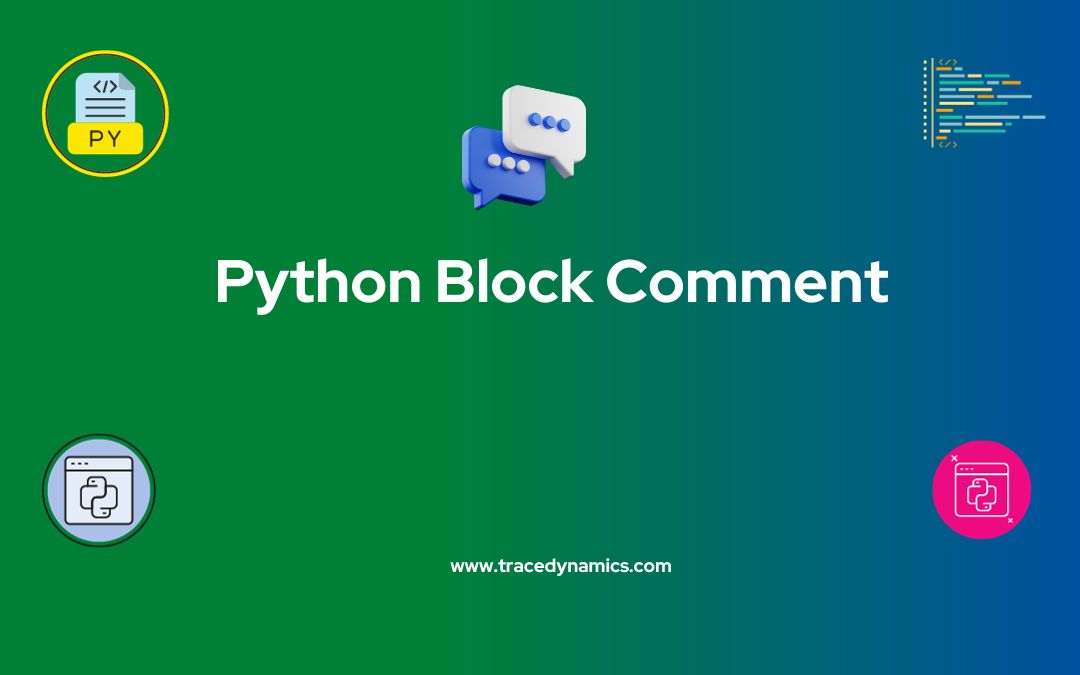
Python
Python Block Comment: Python, a versatile and widely-used programming language, is renowned for its readability and simplicity. One of the critical aspects of writing readable and maintainable code in Python is effective commenting. In this comprehensive guide, we delve into Python block comments, a tool essential for both novice and seasoned programmers.
Key Takeaways:
Introduction to Python Programming
Python, known for its user-friendly syntax and diverse libraries, stands out as a beginner-friendly yet powerful language. Its unique approach to coding, emphasizing readability and efficiency, makes it a preferred choice for various applications, from web development to data science.
What are Block Comments in Python?
Block comments in Python are used to mark sections of code for documentation or debugging purposes. They allow developers to temporarily disable a block of code or provide detailed explanations for complex code segments.
Why Use Block Comments?
- Enhanced Readability: Block comments make it easier for others to understand the purpose and functionality of the code.
- Ease of Debugging: Temporarily disabling code sections can help isolate issues during the debugging process.
- Code Maintenance: Well-commented code is easier to update and maintain, especially in collaborative environments.
# This is a block comment
# It explains the following code
for i in range(5):
print(i)
Importance of Commenting Code
Commenting is crucial in software development for several reasons:
- Knowledge Sharing: Comments provide insights into the developer’s thought process.
- Future Reference: They serve as a guide for future modifications or enhancements.
- Collaboration: Comments help team members understand each other’s code.
Overview of Python Block Comment Syntax
Python uses the # symbol for single-line comments. For block comments, multiple # symbols are used, one for each line of the comment.
Syntax Example:
# This is a single-line comment
# This is a block comment
# spanning multiple lines
When to Use Block Comments in Python
- Complex Logic Explanation: For explaining intricate logic or algorithms.
- Temporary Code Deactivation: To deactivate sections of code for testing.
- Project Documentation: To document the overall functionality of code segments.
Differentiating Single-line and Block Comments
– Single-line Comments: Used for brief explanations or notes.
– Block Comments: Ideal for detailed descriptions or temporarily disabling code.
| Comment Type |
Use Case |
Syntax |
| Single-line |
Short explanations or annotations |
# |
| Block |
Detailed documentation or disabling code |
Multiple # |
Best Practices for Python Block Comments
– Conciseness: Keep comments brief and to the point.
– Relevance: Ensure comments are directly related to the code.
– Clarity: Use clear and understandable language.
# Loop through a list and print each element
for item in my_list:
print(item) # Print the current item
Advanced Uses of Python Block Comments
Python’s simplicity in commenting can be leveraged in more sophisticated coding scenarios. Advanced programmers often use block comments to temporarily disable code sections during debugging or to provide detailed documentation for complex algorithms.
Integrating Block Comments in Projects
When working on larger Python projects, block comments become a crucial tool for:
- Code Organization: Segmenting code into logical blocks.
- Team Communication: Leaving detailed instructions or explanations for team members.
- Version Control: Documenting changes and updates within the code.
# Initializing variables for data processing
x = 10
y = 20
# Temporary disabling the following loop for debugging
# for i in range(x):
# print(i * y)
Frequently Asked Questions (FAQs)
What is a Block of Code?
A block of code refers to multiple lines of code grouped together, usually sharing the same indentation level.
Do we really need multiline comments?
Multiline comments are useful for troubleshooting parts of the code and for providing explanations longer than a single line.
How do you use #’s to comment a block of code?
The # character is used at the beginning of each line to create a block comment in Python.
Can docstrings be used for block comments?
Yes, docstrings, denoted by triple quotes, can be used for creating multiline comments in Python.
Are there alternative methods to comment out code in Python?
Besides block comments and docstrings, modern IDEs offer features to quickly comment out blocks of code.
What are some examples of using multiline comments in Python?
Multiline comments are used for detailed documentation, debugging, and explaining complex logic.
What are the best practices for commenting in Python?
Keep comments concise, relevant, and clear; and use well-named variables, functions, and classes to make the code self-explanatory.
Is it possible to create multiline comments with IDEs?
Yes, many modern IDEs provide shortcuts or features to easily comment or uncomment blocks of code.
Why is commenting important in Python programming?
Commenting enhances code readability, aids in debugging, and facilitates collaboration in team projects.
How does commenting aid in Python code maintenance?
Comments provide context and explanations, making it easier to update and maintain code, especially in collaborative environments.






